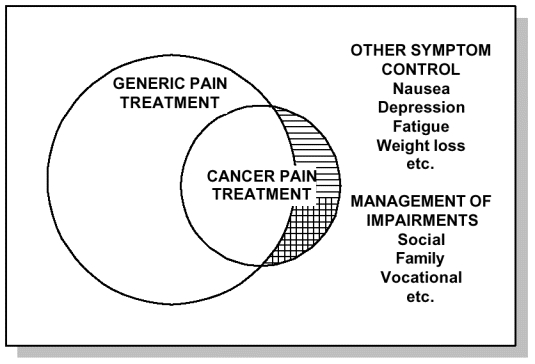From: 1, Introduction

NCBI Bookshelf. A service of the National Library of Medicine, National Institutes of Health.

NOTE: The larger circle denotes techniques broadly applied to
treat many forms of pain regardless of site, chronicity, or etiology.
Such techniques include pharmacologic (NSAIDs, opioids, adjuvants),
anesthetic, and nondrug (cognitive-behavioral or physical) therapies.
The smaller circle denotes treatments for cancer pain, most of which
fall within the larger circle. Of those not included within the larger
circle, some (shown as horizontal stripes) target specific tumor
pathophysiology (e.g., neurolytic celiac plexus block, biphosphonates,
gemcitabine, radionuclides, mitoxantrone). Other treatments for cancer
pain (shown cross-hatched) are less closely influenced by specifics of
tumor biology (e.g., external radiation). Outside of both circles may be
envisaged treatment of the many other symptoms and impairments to
multiple dimensions of health-related quality of life besides pain
itself. The aggregate burden of pain and other symptoms and impairments
is addressed by palliative and supportive care.
From: 1, Introduction

NCBI Bookshelf. A service of the National Library of Medicine, National Institutes of Health.